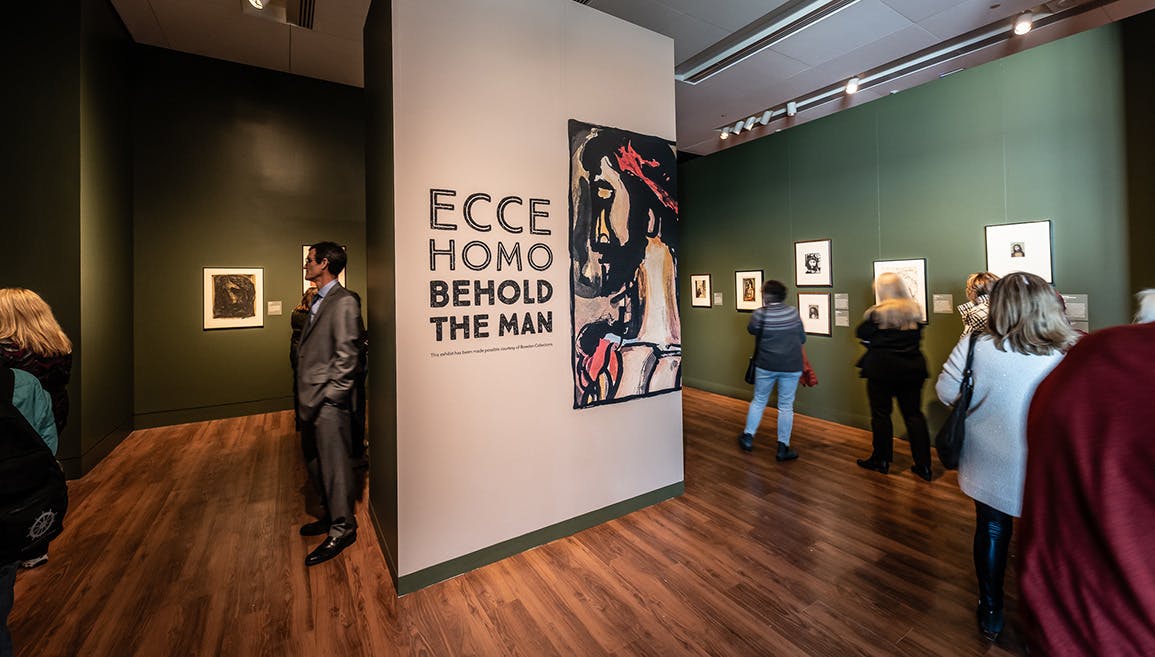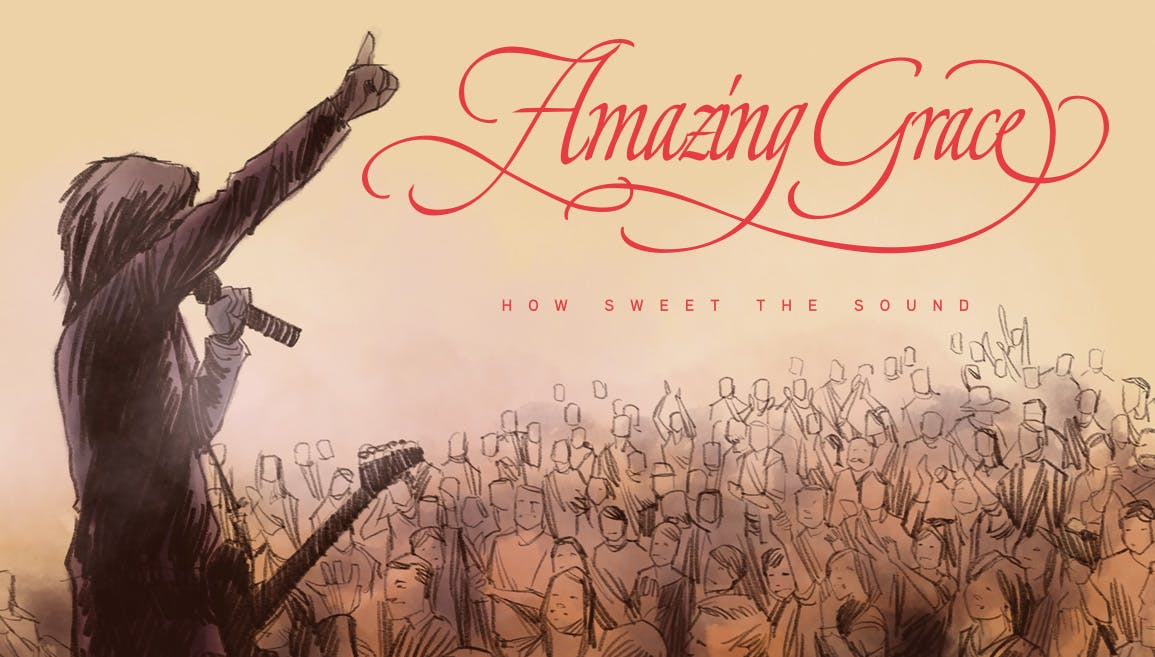Ecce Homo: Behold the Man | Easter at Museum of the Bible

As early as the fourth century AD, Christians began traveling great distances to pray along a set path through the streets of Jerusalem, following the journey Jesus took to the cross. This path became known as the Via Dolorosa, a Latin term meaning the “Sorrowful Way” or “Way of Sorrow,” with 14 stops reflecting on the suffering Jesus endured. For those who could not travel, a virtual pilgrimage was developed as a way for Christians to imitate walking the Via Dolorosa, by pausing at each stop arranged around the interior of a church. This became known as the “Stations of the Cross” and is present in thousands of churches around the world.
The first station on this journey is at the praetorium of the Roman ruler Pontius Pilate, who brings Jesus out before the crowd for judgment and says in the Gospel of John, “Behold the man!” (Latin: “Ecce homo!”) This moment has since been visualized by hundreds of artists, each bringing their perspective to the suffering of Jesus during his trial, crucifixion, and death. In art history, this depiction of Jesus crowned with thorns and wearing a purple robe has come to be called, among other things, the “Ecce Homo,” after the phrase in John.
The earliest depictions of the “Ecce Homo” scene appear in the ninth and tenth centuries by Syrian-Byzantine artists, who often portrayed Jesus surrounded by people outside of the praetorium, crowned with thorns, and wearing a purple robe as described in the Gospels. By the fifteenth century, however, this image had begun to focus primarily on the wounded figure of Jesus, becoming a symbolic remembrance of the event rather than a realistic depiction of the biblical scene. By the twentieth century, the image had zoomed in even further to the raw expression on the face of Jesus, punctuated with harsh lines, tight frames, and dynamic color palettes. These changes in focus can be seen in the artworks below, and can be explored in more depth in our Easter exhibit, Ecce Homo: Behold the Man.
Early Depictions: Setting a Scene
This etching by Cornelis Cort is a seventeenth-century example of those earlier depictions of the scene that included many elements from the biblical story. By including these elements, it became an educational tool: one could view this scene and imagine the event. Jesus is the central figure, his full body is on display outside Pilate’s palace, with the city gate in the background. Jesus is shown with tied hands, a tilted head adorned with a crown of thorns, and a robe wrapped around his arm. Pilate presents Jesus to the angry crowd, which is carrying a cross, foreshadowing his fate.

Ecce Homo
Cornelis Cort (1533–1578)
Netherlands
Etching and engraving
1602
Another seventeenth-century etching, by Jacques Callot, is similar. His rendition of the traditional “Ecce Homo” scene is detailed in its depictions of people, lighting, architecture, and perspective. The central focal point converges on the figure of Jesus. He is not the largest figure in the frame, but is distinguished by the open space in front of him and a light that descends on his head like a halo. His outstretched arms mimic the shape of the cross in the foreground.

Christ Shown to the People
Jacques Callot (1592–1635)
France
Etching
1618
Evolving Depictions: Focusing on Jesus
While the two etchings above display a more traditional scene, others from the same century embraced the evolution of the “Ecce Homo” that focused on Jesus alone. Western Renaissance and Baroque art are rife with religious depictions like this one after Guido Reni, which is the quintessential “Ecce Homo” image. The bust of Jesus’s head is tilted toward heaven with a longing and sorrowful stare. He does not look seriously wounded; his complexion and hair are nearly flawless, yet traces of blood are seen trailing down his neck and forehead as the crown of thorns pierces his head.

Ecce Homo (after Guido Reni)
W. French
France
Engraving
17th century
This formula for depicting the suffering of Christ lasted for hundreds of years and continues to be popular today. This is evidenced by the large number of churches and homes with a picture like this hung on the wall—like the Head of Christ seen below that hung in a church in Bolivia—as well as by the number of replicas seen throughout the Western world during the centuries that followed, like the holy card from 1870 depicted here.

Head of Christ
Unknown artist
Spain
Oil on panel
1680–1820

Ecce Homo
Unknown artist
France
Paper lace
1870
Modern Depictions: Connecting with Suffering
In the twentieth century, the “Ecce Homo” scene evolved yet again. After the ravages of two world wars, suffering was vivid in people’s imagination, interpreted as raw, brutal, and ugly. No longer was the face of Jesus barely bleeding or his hair perfectly quaffed. He was beaten, bruised, bleeding, and mocked. This image of Jesus by Otto Dix, an artist who was considered degenerate by the Nazis, is fraught with bold, jagged lines and busy patterns, evoking a sense of chaos and pain typical of the German Expressionists. Jesus is depicted against a brick wall with people blocking him in front. He is clothed with a robe and crowned with thorns, holding the rod with which he was beaten.

Ecce Homo (from Matthaüs Evangelium)
Otto Dix (1891–1969)
France
Lithograph
1960
Jesus’s eyes are no longer cast upward. Instead, he looks down in sorrow or directly at the viewer, like in this etching by Michel Ciry. Here, Jesus is depicted with an elongated face and large eyes. His drawn face and gaunt appearance intensify the sense of loneliness and suffering Jesus must have felt. The tight frame and brick wall in the background create a claustrophobic space, and the nail-like clasp about his robe portends his destiny.

Ecce Homo
Michel Ciry (1919–2018)
France
Etching
1962
One final example of the modern Ecce Homo scene is Bruce Herman’s O Sacred Head, from a series of images he produced on the theme of Christ’s suffering. In this etching, Herman departed slightly from the established formula for the scene and instead chose to depict the moment Jesus is being tortured, blindfolded, and crowned with thorns. The many hands surrounding him create a suffocating chaos around his head. The blindfold alludes to both the swaddling clothes he was wrapped in as a baby and the cloth left behind in the empty tomb, symbolizing redemption through his birth, death, and resurrection.

O Sacred Head
Bruce Herman (1953–)
United States
Etching
1993
Our life experiences, culture, and time have a profound impact on the way we understand and internalize the suffering and death of Jesus. It is especially poignant during the Easter season, and it is my hope that this exhibition will offer our guests a space to reflect—not only on the suffering and sacrifice of Jesus, which is a monumental event in the lives of Christians, but also on the concept of endurance through pain, which is an experience shared by us all.
These works, among many others, are on display in our Easter exhibit, Ecce Homo: Behold the Man, which explores how 21 artists across five centuries, multiple genres, and mixed media have visualized the moment Jesus stood trial, interpreting the concept of suffering as it is uniquely understood by the artist and by the viewer.
Explore Ecce Homo: Behold the Man, open through May 15, 2024, and celebrate Easter with us at Museum of the Bible. Learn more about the exhibit here.
By Amy Van Dyke, Lead Curator of Art and Exhibitions


